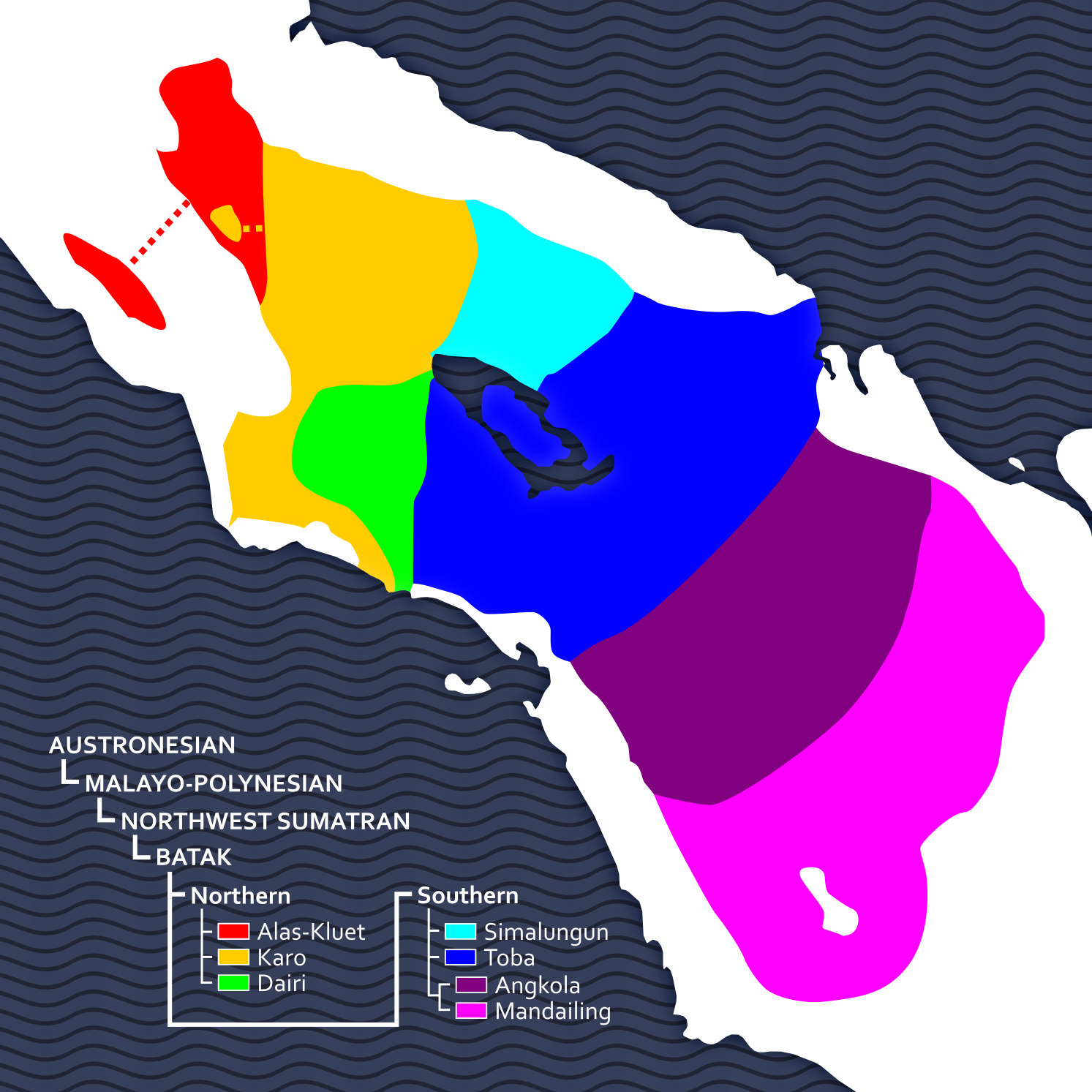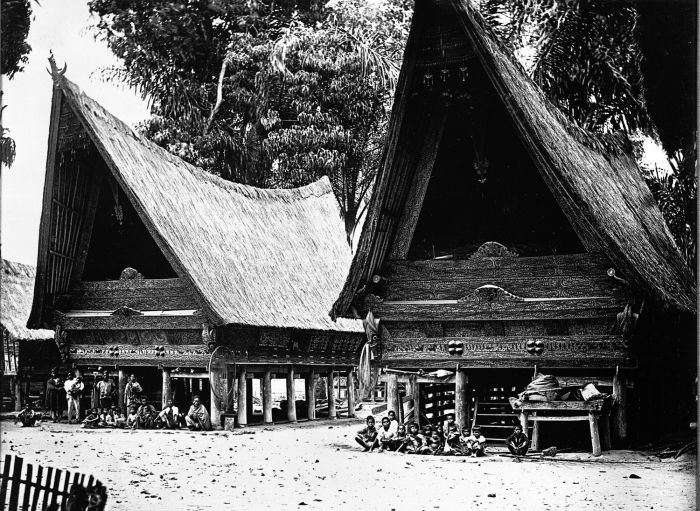Toba Batak language on:
[Wikipedia]
[Google]
[Amazon]
 Toba Batak () is an Austronesian language spoken in
Toba Batak () is an Austronesian language spoken in
 There are several dictionaries and grammars for each of the five major dialects of Batak (Angkola-Mandailing, Toba, Simalungun, Pakpak-Dairi, and Karo). Specifically for Toba Batak the most important dictionaries are that of Johannes Warneck (Toba-German) and
There are several dictionaries and grammars for each of the five major dialects of Batak (Angkola-Mandailing, Toba, Simalungun, Pakpak-Dairi, and Karo). Specifically for Toba Batak the most important dictionaries are that of Johannes Warneck (Toba-German) and
 Cole and Hermon (2008) claim that VOS order is the result of VP-raising (specifically, of VoiceP) (Figure 1). Then, the subject may optionally raise over the verb phrase because of information structure. This analysis provides a basis for understanding Austronesian languages that have more fully become SVO (e.g. Indonesian: Chung 2008; Jarai: Jensen 2014).
Like many Austronesian languages (e.g.
Cole and Hermon (2008) claim that VOS order is the result of VP-raising (specifically, of VoiceP) (Figure 1). Then, the subject may optionally raise over the verb phrase because of information structure. This analysis provides a basis for understanding Austronesian languages that have more fully become SVO (e.g. Indonesian: Chung 2008; Jarai: Jensen 2014).
Like many Austronesian languages (e.g.
Musgrave, Simon (2001). Non-subject Arguments in Indonesian. Ph.D. Thesis
See page 101 and reference to Cole, Peter & Gabriella Hermon (2000) Word order and binding in Toba Batak. Paper presented at AFLA 7, Amsterdam * * * * * * *
OLAC resources in and about the Batak Toba language
Example translation of Biblical Scripture
(published by th
Language Museum
a site published by Zhang Hong, an internet consultant and amateur linguist in Beijing China)
Sejara Indonesia
An Online Outline of Indonesia History. {{Authority control Batak languages Languages of Indonesia
 Toba Batak () is an Austronesian language spoken in
Toba Batak () is an Austronesian language spoken in North Sumatra
North Sumatra ( id, Sumatra Utara) is a province of Indonesia located on the northern part of the island of Sumatra. Its capital and largest city is Medan. North Sumatra is Indonesia's fourth most populous province after West Java, East Java and ...
province in Indonesia
Indonesia, officially the Republic of Indonesia, is a country in Southeast Asia and Oceania between the Indian and Pacific oceans. It consists of over 17,000 islands, including Sumatra, Java, Sulawesi, and parts of Borneo and New Gui ...
. It is part of a group of languages called Batak
Batak is a collective term used to identify a number of closely related Austronesian ethnic groups predominantly found in North Sumatra, Indonesia, who speak Batak languages. The term is used to include the Karo, Pakpak, Simalungun, Tob ...
.
There are approximately 1,610,000 Toba Batak speakers, living to the east, west and south of Lake Toba. Historically it was written using Batak script, but the Latin script
The Latin script, also known as Roman script, is an alphabetic writing system based on the letters of the classical Latin alphabet, derived from a form of the Greek alphabet which was in use in the ancient Greek city of Cumae, in southern ...
is now used for most writing.
Nomenclature
The name of thislanguage
Language is a structured system of communication. The structure of a language is its grammar and the free components are its vocabulary. Languages are the primary means by which humans communicate, and may be conveyed through a variety of ...
arises from a rich and complex history of ethnic identity in colonial and post-colonial Indonesia
Indonesia, officially the Republic of Indonesia, is a country in Southeast Asia and Oceania between the Indian and Pacific oceans. It consists of over 17,000 islands, including Sumatra, Java, Sulawesi, and parts of Borneo and New Gui ...
. It is a generic name for the common language used by the people of the districts of Toba, Uluan, Humbang, Habinsaran, Samosir, and Silindung, centered upon the Island of Sumatra
Sumatra is one of the Sunda Islands of western Indonesia. It is the largest island that is fully within Indonesian territory, as well as the sixth-largest island in the world at 473,481 km2 (182,812 mi.2), not including adjacent i ...
; more particularly, at Lake Toba. Linguistically and culturally these tribes of people are closely related. Other nearby communities such as Silalahi and Tongging may also be classified as speakers of Toba Batak.
The term ''Toba Batak'' is, itself, a derivation of the Toba Batak language. As such, it is used both as a noun and an adjective, both to describe a language, and also to describe the people who speak the language.
Among the aforementioned districts, Toba is the most densely populated and politically the most prominent district so that ''Toba Batak'' became a label for all communities speaking a dialect closely akin to the dialect spoken in Toba. In contemporary Indonesia the language is seldom referred to as ''Toba Batak'' (), but more commonly and simply as ''Batak'' (). The (Toba)-Batak refer to it in their own language as . This "Batak" language is different from the languages of other Batak people that can be divided into speaking a northern Batak dialect (Karo Batak
Karo may refer to:
Ethnic groups
* Karo people (East Africa), a group of tribes in East Africa
* Karo people (Ethiopia), an ethnic group from Ethiopia
* Karo people (Indonesia), the indigenous people of the Karo Plateau in North Sumatra
Languag ...
, and Pakpak-Dairi Batak – linguistically this dialect group also includes the culturally very different Alas people), a central Batak dialect (Simalungun
Simalungun Regency is a regency in North Sumatra, Indonesia. Its seat was formerly at Pematangsiantar, but this city was in recent years separated from the Regency and made into an independent city (''kota''), although it remains geographically s ...
) and closely related other southern Batak dialects such as Angkola and Mandailing.
Background
 There are several dictionaries and grammars for each of the five major dialects of Batak (Angkola-Mandailing, Toba, Simalungun, Pakpak-Dairi, and Karo). Specifically for Toba Batak the most important dictionaries are that of Johannes Warneck (Toba-German) and
There are several dictionaries and grammars for each of the five major dialects of Batak (Angkola-Mandailing, Toba, Simalungun, Pakpak-Dairi, and Karo). Specifically for Toba Batak the most important dictionaries are that of Johannes Warneck (Toba-German) and Herman Neubronner van der Tuuk
Herman Neubronner van der Tuuk (23 February 1824 – 17 August 1894) was a Bible translator and linguist specialising in the languages of the Dutch East Indies.
Early years and studies
Van der Tuuk was born in Malacca (part of the Dutch Ea ...
(Toba-Dutch). The latter was also involved in translating the Christian Bible
The Bible (from Koine Greek , , 'the books') is a collection of religious texts or scriptures that are held to be sacred in Christianity
Christianity is an Abrahamic monotheistic religion based on the life and teachings of Jesus ...
into Toba Batak.
Phonology
This description follows Nababan (1981).Consonants
Vowels
Note: * only occurs in loanwords from Indonesian.Stress
Stress is phonemic, e.g. 'height' vs. 'high'; 'black dye' vs. 'your sibling'.Syntax
Toba Batak hasverb-initial
In syntax, verb-initial (V1) word order is a word order in which the verb appears before the subject and the object. In the more narrow sense, this term is used specifically to describe the word order of V1 languages (a V1 language being a languag ...
, VOS word order, as with many Austronesian languages. In (1), the verb 'eat' precedes the object 'cake', and the verb phrase precedes 'the child'.
SVO word order (as in English), however, is also very common (Cole & Hermon 2008). In (2), the subject 'this child' precedes the verb phrase 'hit the dog'.
 Cole and Hermon (2008) claim that VOS order is the result of VP-raising (specifically, of VoiceP) (Figure 1). Then, the subject may optionally raise over the verb phrase because of information structure. This analysis provides a basis for understanding Austronesian languages that have more fully become SVO (e.g. Indonesian: Chung 2008; Jarai: Jensen 2014).
Like many Austronesian languages (e.g.
Cole and Hermon (2008) claim that VOS order is the result of VP-raising (specifically, of VoiceP) (Figure 1). Then, the subject may optionally raise over the verb phrase because of information structure. This analysis provides a basis for understanding Austronesian languages that have more fully become SVO (e.g. Indonesian: Chung 2008; Jarai: Jensen 2014).
Like many Austronesian languages (e.g. Tagalog
Tagalog may refer to:
Language
* Tagalog language, a language spoken in the Philippines
** Old Tagalog, an archaic form of the language
** Batangas Tagalog, a dialect of the language
* Tagalog script, the writing system historically used for Taga ...
), DP ''wh''-movement is subject to an extraction restriction (e.g. Rackowski & Richards 2005). The verb in (3a) must agree with 'what' (in (3a): TT or "theme-topic") for it to be extracted in front of the verb. If the verb agrees with the subject, 'John' (in (3b): AT or "actor-topic"), ''aha'' 'what' may not extract.
Notes
References
Musgrave, Simon (2001). Non-subject Arguments in Indonesian. Ph.D. Thesis
See page 101 and reference to Cole, Peter & Gabriella Hermon (2000) Word order and binding in Toba Batak. Paper presented at AFLA 7, Amsterdam * * * * * * *
External links
OLAC resources in and about the Batak Toba language
Example translation of Biblical Scripture
(published by th
Language Museum
a site published by Zhang Hong, an internet consultant and amateur linguist in Beijing China)
Sejara Indonesia
An Online Outline of Indonesia History. {{Authority control Batak languages Languages of Indonesia